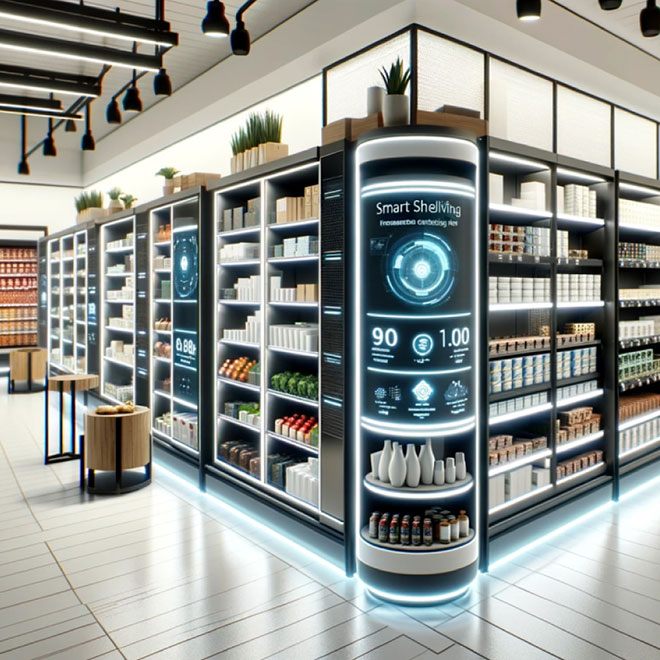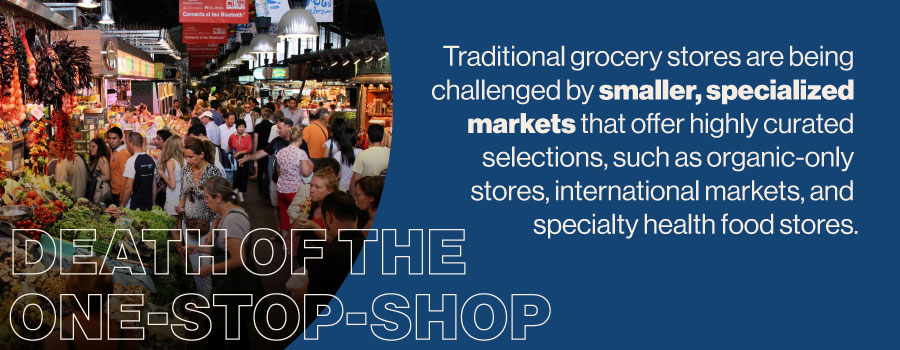
The Grocery Revolution Part 2 of 3: The Next 10 Years
How Specialized Markets and the Climate Era are Redefining the Grocery Industry
Estimated Read Time: 3 Minutes
In our previous installment, we explored how connective services and AI will transform grocery shopping in the next decade (read the article here). Now, we shift our focus to two critical areas that will redefine the industry: the evolution of specialized markets versus mass markets, and the growing importance of sustainability in the climate era. As we explore these themes, we’ll uncover how grocers can position themselves at the forefront of these transformative shifts.
The Rise of Specialized Markets: The Death of the One-Stop-Shop?
The grocery landscape is becoming increasingly fragmented. Consumers are no longer satisfied with the traditional one-stop-shop model that dominated the market for decades. Instead, they are seeking out more specialized experiences that cater to their unique needs and preferences.
Recent data shows that consumers visited an average of 20.7 different retailers between March 2023 and February 2024 for their grocery needs, up 23% from the same period between 2019-2020.1 This shift is driven by several factors, including the rise of global cuisines, the desire for authentic, niche products, and the need for more curated shopping experiences. Traditional grocery stores, with their broad product ranges, are being challenged by smaller, specialized markets that offer highly curated selections, such as organic-only stores, international markets, and specialty health food stores.
The implications for grocery retailers are profound. The center store, which has long been a staple of the grocery experience, is under threat. As consumers become more discerning, they are shifting their spending away from commoditized products and toward items that offer greater value, whether through quality, health benefits, or sustainability.
For grocers, this means rethinking the store layout and product assortment. The focus is moving toward creating “stores within stores” that cater to specific consumer needs, whether that’s a dedicated section for plant-based foods, a global flavors aisle, or even in-store experiences like cooking classes or health consultations. Grocers that can create a more personalized, engaging shopping experience will stand out in this increasingly competitive market.

Mass Markets: Adapting to a New Reality
While specialized markets are on the rise, mass market retailers are not going anywhere. However, they too must adapt to remain relevant. The key for mass market grocers will be to leverage their scale to offer both variety and value while integrating the personalized experiences that consumers now demand.
One approach is to use data and AI to offer customized shopping experiences at scale. By analyzing shopping behaviors, preferences, and even dietary needs, mass market retailers can create personalized promotions, suggest tailored meal plans, and optimize product placements to drive engagement and loyalty. This blend of broad assortment with personalized service is the future of mass market grocery.
The Climate Era: Sustainability as a Business Imperative
As we look toward 2040, it is clear that climate change will be a defining issue for the grocery industry. The days of ignoring environmental impacts are over; consumers are demanding transparency and accountability, and businesses are recognizing the urgent need for sustainable practices.
Sustainability in grocery goes beyond reducing plastic use or sourcing organic produce. It’s about rethinking the entire supply chain. Grocers must consider the environmental impact of everything from farming practices to transportation and packaging. Blockchain technology, for example, is being used to provide transparency in the supply chain, ensuring that products are sourced sustainably and ethically.
Moreover, the integration of technology like IoT and AI will enable more efficient operations and reduce waste. Smart shelves and predictive inventory systems can minimize overstocking and understocking, while drone deliveries and localized fulfillment centers can reduce the carbon footprint associated with logistics.
Grocers are also taking on a new role as educators and advocates for sustainable living. By curating product assortments that align with sustainable values and providing information on the environmental impact of various products, grocers can guide consumers toward more sustainable choices. This aligns with the broader cultural shift toward sustainability, where consumers are increasingly considering the environmental and ethical implications of their purchases.

The Path Forward: Building Resilience in a Changing World
The grocery industry is at a crossroads. The rise of specialized markets and the imperative of sustainability present both challenges and opportunities. Grocers that can innovate and adapt to these trends will be well-positioned to thrive in the coming decades.
In the next installment of this series, we’ll jump further in the future and explore the 2040 consumer. Stay tuned as we continue to chart the future of grocery.
By understanding and preparing for these shifts, grocers can not only survive but lead the charge in the grocery revolution.

 Amanda Seevers
Amanda Seevers Jay Highland
Jay Highland


